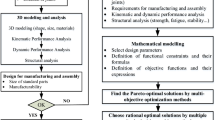Abstract
A study for the replacement of a metallic swing-arm of a high performance motorcycle with a composite part is presented. Considering the high structural effectiveness of the original metallic component, the case study evaluates the potential of composites in a challenging application. The FE model of the original component is developed to evaluate the structural performance in the most significant load conditions. A manufacturing process, based on a RTM technique, is proposed and analysed in order to develop realistic design hypotheses. The design approach is based on an optimisation process with 60 design variables. A constrained multi-objective genetic algorithm is applied to identify the solutions representing the best trade-off between mass reduction and improvement of torsional stiffness. Results show that composite materials can enhance the structural efficiency of the original metallic part, even considering technological limitations and damage tolerance requirements.














Similar content being viewed by others
References
Beardmore, P.: Composite structures for automobiles. Compos. Struct. 5, 163–176 (1986)
Smith, G.F.: Design and production of composites in the automotive industries. Compos. Manuf. 1(2), 112–116 (1990)
Pinfold, M., Calvert, G.: Experimental analysis of a composite automotive suspension arm. Compos. 25(1), 56–93 (1994)
Verrey, J., Wakeman, M.D., Michaud, V., Manson, J.-A.E.: Manufacturing cost comparison of thermoplastic and thermoset RTM for an automotive floor pan. Compos. Part A 37, 9–22 (2006)
Sherman, A.M., Krause, A.R., Friedman, P.A., Steenkamer, D.A., Houston, D.Q.: Automotive body materials. In: Buschow, K.H.J., Cahn, R.W., Flemings, M.C., Ilschner. B. (eds.) Encyclopedia of Material: Science and Technology, pp. 415–421. Elsevier Science Ltd. (2001)
Corum, J.M., Battiste, R.L., Ruggles-Wrenn, M.B.: Low-energy impact effects on candidate automotive structural composites. Compos. Sci. Technol. 63, 757–769 (2003)
Legrand, M., Ngoc, Q.A.P.: A study of feasibility of a monoblock racing motorcycle rim. Compos. Sci. Technol. 61, 453–458 (2001)
Santoni, C.: The CFRP MP4-12C Chassis. 10th Automotive Composites Conference and Exhibition, Troy, MI, USA. Sept. 15–16, 2010
Feroboli, P., DeOto, L.: Carbon fiber composite research and development at Automobili Lamborghini. 10th Automotive Composites Conference and Exhibition, Troy, MI, USA. Sept. 15–16, 2010
Ghiasi, H., Lessard, L., Pasini, D., Thouin, M.: Optimum structural and manufacturing design of a braided hollow composite part. Appl. Compos. Mater. 17, 159–173 (2010)
Iwasaki, H., Mizuta, A., Hasegawa, T., Yoshitake, H.: Development of a magnesium swing arm for motorcycles. SAE Paper 2004-32-0048. Proceedings of Small Engine Technology Conference & Exposition, Graz, Osterreich, September 2004
Schmit Jr., L.A., Farshi, B.: Optimum laminated design for strength and stiffness. Int. J. Numer. Meth. Eng. 7, 519–536 (1977)
Ghiasi, H., Pasini, D., Lessard, L.: Optimum stacking sequence of composite materials Part I: Constant stiffness design. Compos. Struct. 90, 1–11 (2009)
Ghiasi, H., Fayazbakhsh, K., Pasini, D., Lessard, L.: Optimum stacking sequence of composite materials Part I: variable stiffness design. Compos. Struct. 93, 1–13 (2010)
Todoroki, A., Haftka, R.T.: Stacking sequence optimisation by a genetic algorithm with a new recessive gene like repair strategy. Compos. Part B 29B, 277–285 (1998)
Todoroki, A., Ishilawa, T.: Design of experiments for stacking sequence optimizations with genetic algorithm using response surface approximation. Compos. Struct. 64, 349–357 (2004)
Todoroki, A., Terada, Y.: Improved fractal branch and bound method for stacking-sequence optimizations of laminates. AIAA J. 42(1), 141–148 (2004)
Tabakov, P.Y.: Multi-dimensional design optimisation of laminated structures using an improved genetic algorithm. Compos. Struct. 54, 349–54 (2001)
Nagendra, S., Jestin, D., Gurdal, Z., Haftka, R.T., Watson, L.T.: Improved genetic algorithm for the design of stiffened composite panels. Comput. Struct. 58(3), 543–55 (1996)
Park, C.H., Lee, W.I., Han, W.S., Vautrin, A.: Simultaneous optimization of composite structures considering mechanical performances and manufacturing cost. Compos. Struct. 65, 117–127 (2004)
Cossalter, V.: Cinematica e Dinamica della Motocicletta. Edizioni Progetto, Padova (2001)
Abaqus® 6.10 documentation. 2010. Dassault Systèmes Simulia Corp., Providence, RI, USA (2010)
Ferret, B., Anduze, M., Nardari, C.: Metal inserts in structural composite materials manufactured by RTM. Compos. Part A 29(5–6), 693–700 (1998)
Department of Defense Handbook: Composite Materials Handbook, Vol. 2. Polymet Matrix Composites Material Properties, MIL-HDBK-17-2E. Department of Defense, USA (1999)
Lehmann, U., Michaeli, W.: Cores lead to an automated production of hollow composite parts in resin transfer moulding. Compos. Part A 29(7), 803–810 (1998)
Marsh, G.: Augmenting core values. J. Reinf. Plast. 51(5), 34–38 (2007)
Stewart, R.: Sandwich structures deliver core benefits. J. Reinf. Plast. 54(4), 32–37 (2010)
ArmaFROM PET AC Technical Data. http://www.armacell-foam-cores.com/ . Accessed 24 July 2011
Nexus: User Manuals – Keywords. iChrome Ltd. Bristol (2011)
Deb, K., Agrawal, S., Pratap, A., Meyarivan, T.: A fast and elitist multiobjective genetic algorithm: NSGA-II. IEEE Trans. Evol. Comput. - TEC 6(2), 182–197 (2002)
Acknowledgements
This research activity was carried out within the FIRB project “Potenziamento e sviluppo dell’industria motoristica incluse le due ruote con motori a basso consumo e basso impatto ambientale”, founded by the Italian Ministry of Research (PNR 2005-2007/DM N. 1028/Ric). The authors would like to thank Prof. Luca Di Landro for his precious support.
Author information
Authors and Affiliations
Corresponding author
Rights and permissions
About this article
Cite this article
Airoldi, A., Bertoli, S., Lanzi, L. et al. Design of a Motorcycle Composite Swing-Arm by Means of Multi-objective Optimisation. Appl Compos Mater 19, 599–618 (2012). https://doi.org/10.1007/s10443-011-9227-6
Received:
Accepted:
Published:
Issue Date:
DOI: https://doi.org/10.1007/s10443-011-9227-6




